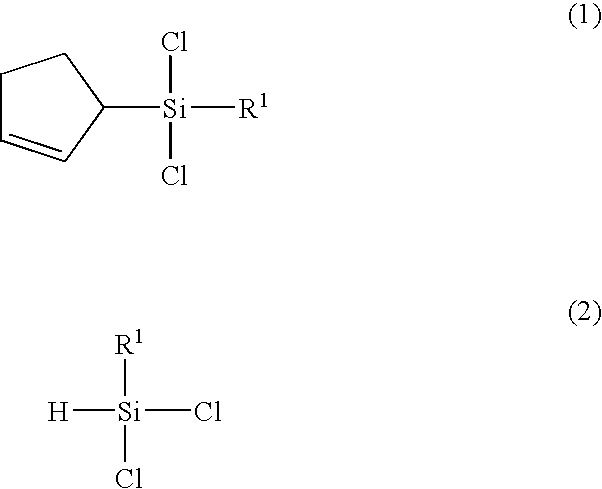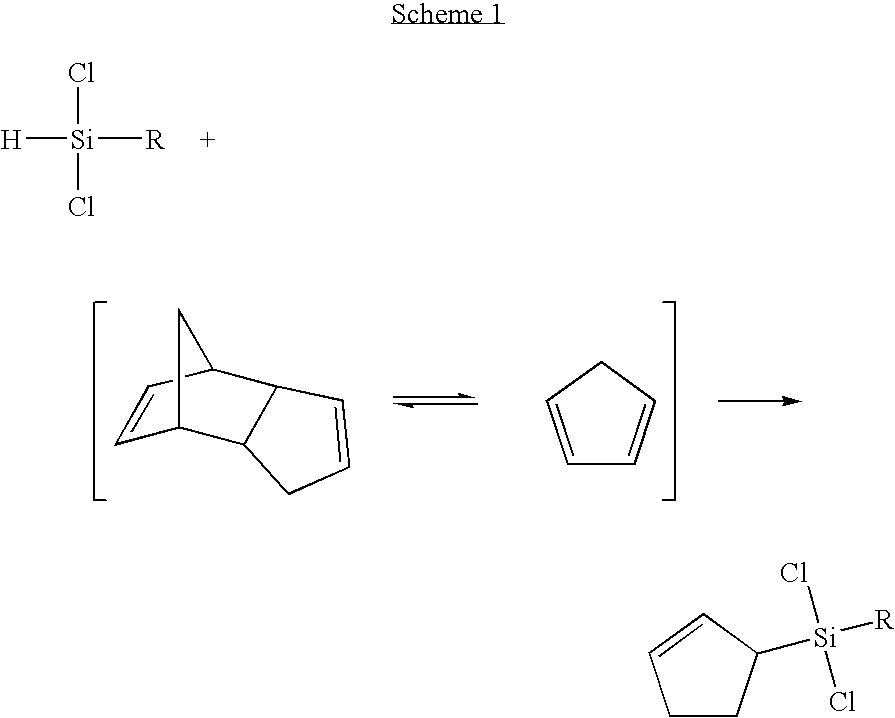(2-cyclopentenyl)chlorosilanes and their preparation methods
a technology of chlorosilane and cyclopentadiene, which is applied in the field of (2cyclopentenyl) chlorosilane derivatives, can solve the problems of reducing economical efficiency, raising prime cost, and conventional methods using expensive cyclopentadiene instead of dicyclopentadien
- Summary
- Abstract
- Description
- Claims
- Application Information
AI Technical Summary
Problems solved by technology
Method used
Image
Examples
example 1
Reaction with Dicyclopentadiene and Trichlorosilane
[0052]A reactor of 300 mL stainless steel tube was dried under nitrogen. 15.0 g (0.113 mol) of dicyclopentadiene, 122.4 g (0.904 mol) of trichlorosilane, 51 mL of toluene, 17 mL of hexadecane were added in the reactor. The reactor was sealed and the reaction was performed at 250° C. for 1 hour. The termination of reaction was verified by gas chromatography (GC / TCD). Products were subject to simple vacuum distillation, thereby providing a mixture (203.6 g) of (2-cyclopentenyl)trichlorosilane (34.4 g, 76%), 1,3-bis(trichlorosilyl)cyclopentane (1.4%), unreacted trichlorosilane, toluene and hexadecane.
[0053]Products separated from fractional vacuum distillation were identified by the analysis of MS (mass spectroscopic) data and NMR data.
(2-cyclopentenyl)trichlorosilane
[0054](1H-NMR, CDCl3, ppm): 2.13-2.25(m, 2H, CH2CH2CH), 2.43-2.51(m, 2H, CH2CH2CH), 2.66-2.75(m, 1H, CH2CH2CH), 5.77-5.72, 5.93-5.97(m, 2H, CH═CH)
example 2
Reaction with Dicyclopentadiene and Dichlorosilane
[0055]As described in Example 1, 0.909 g (0.00688 mol) of dicyclopentadiene, 4.17 g (0.0413 mol) of dichlorosilane, 5 mL of toluene and 2 mL of hexadecane were placed in a reactor. The reactor was sealed and the reaction was performed at 250° C. for 1 hour. Products were subject to simple vacuum distillation, thereby providing a mixture (9.09 g) of (2-cyclopentenyl)dichlorosilane (1.2 g, 51.0%), unreacted dichlorosilane, toluene and hexadecane.
(2-cyclopentenyl)dichlorosilane
[0056](1H-NMR, CDCl3, ppm): 2.04-2.24(m, 2H, CH2CH2CH), 2.40-2.47(m, 2H, CH2CH2CH), 2.49-2.55(m, 1H, CH2CH2CH), 5.37(d, J=1.5 Hz, 1H, SiH), 5.67-5.71, 5.88-5.92(m, 2H, CH═CH)
example 3
Reaction with Dicyclopentadiene and Methyldichlorosilane
[0057]As described in Example 2, 1.49 g (0.0113 mol) of dicyclopentadiene, 10.79 g (0.0902 mol) of methyldichlorosilane, 5 mL of toluene and 2 mL of hexadecane were placed in a reactor. The reactor was sealed and the reaction was performed at 250° C. for 1 hour. Products were subject to simple vacuum distillation, thereby providing a mixture (15.99 g) of (2-cyclopentenyl)methyldichlorosilane (1.2 g, 29%), unreacted methyldichlorosilane, toluene and hexadecane.
(2-cyclopentenyl)methyldichlorosilane
[0058](1H-NMR, CDCl3, ppm): 0.72(s, 3H, CH3), 2.00-2.21(m, 2H, CH2CH2CH), 2.38-2.43(m, 2H, CH2CH2CH), 2.44-2.49(m, 1H, CH2CH2CH), 5.67-5.71, 5.83-5.87(m, 2H, CH═CH)
PUM
| Property | Measurement | Unit |
|---|---|---|
| boiling point | aaaaa | aaaaa |
| volume ratio | aaaaa | aaaaa |
| mol % | aaaaa | aaaaa |
Abstract
Description
Claims
Application Information
 Login to View More
Login to View More - R&D
- Intellectual Property
- Life Sciences
- Materials
- Tech Scout
- Unparalleled Data Quality
- Higher Quality Content
- 60% Fewer Hallucinations
Browse by: Latest US Patents, China's latest patents, Technical Efficacy Thesaurus, Application Domain, Technology Topic, Popular Technical Reports.
© 2025 PatSnap. All rights reserved.Legal|Privacy policy|Modern Slavery Act Transparency Statement|Sitemap|About US| Contact US: help@patsnap.com



